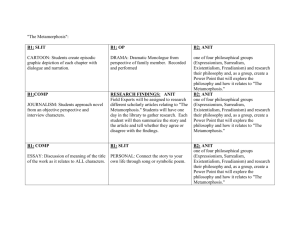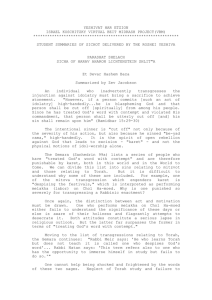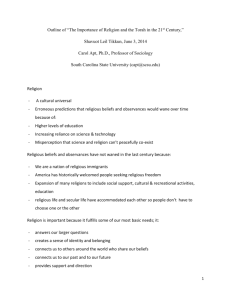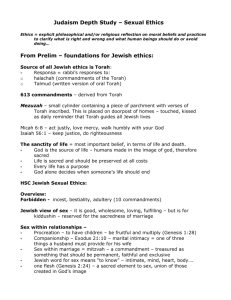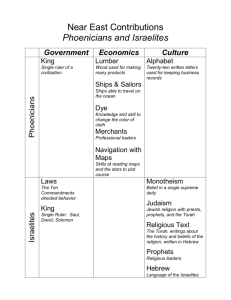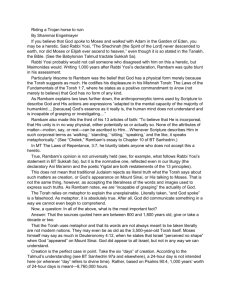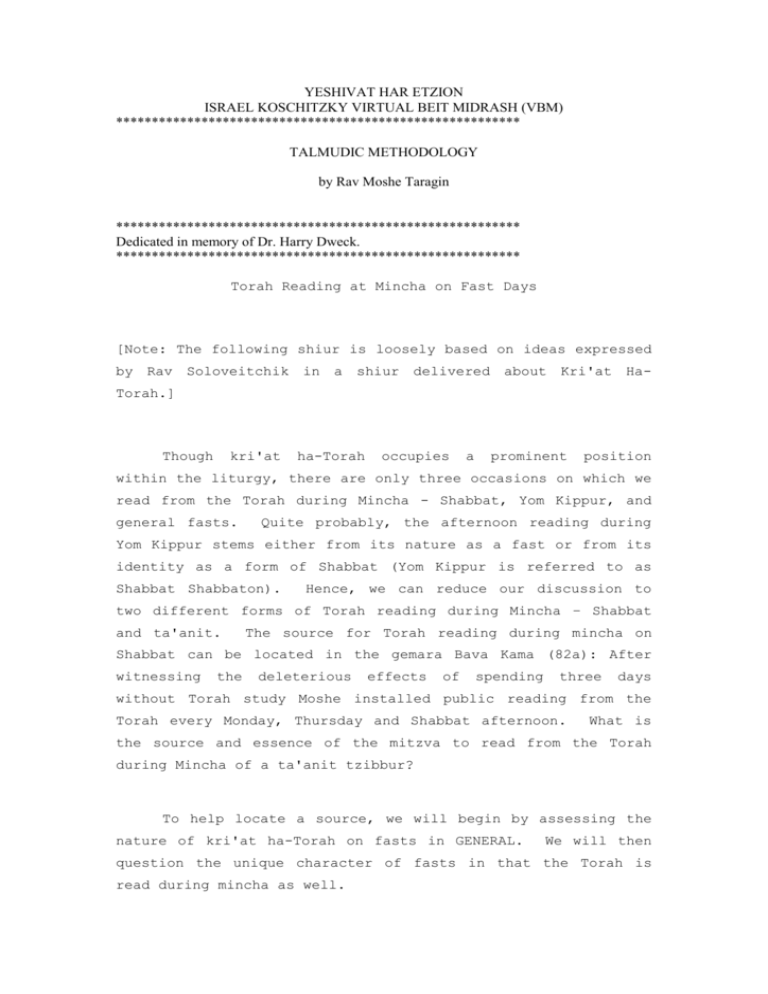
YESHIVAT HAR ETZION
ISRAEL KOSCHITZKY VIRTUAL BEIT MIDRASH (VBM)
*********************************************************
TALMUDIC METHODOLOGY
by Rav Moshe Taragin
*********************************************************
Dedicated in memory of Dr. Harry Dweck.
*********************************************************
Torah Reading at Mincha on Fast Days
[Note: The following shiur is loosely based on ideas expressed
by Rav Soloveitchik in a shiur delivered about Kri'at HaTorah.]
Though
kri'at
ha-Torah
occupies
a
prominent
position
within the liturgy, there are only three occasions on which we
read from the Torah during Mincha - Shabbat, Yom Kippur, and
general fasts.
Quite probably, the afternoon reading during
Yom Kippur stems either from its nature as a fast or from its
identity as a form of Shabbat (Yom Kippur is referred to as
Shabbat Shabbaton).
Hence, we can reduce our discussion to
two different forms of Torah reading during Mincha – Shabbat
and ta'anit.
The source for Torah reading during mincha on
Shabbat can be located in the gemara Bava Kama (82a): After
witnessing
the
deleterious
effects
of
spending
three
days
without Torah study Moshe installed public reading from the
Torah every Monday, Thursday and Shabbat afternoon.
What is
the source and essence of the mitzva to read from the Torah
during Mincha of a ta'anit tzibbur?
To help locate a source, we will begin by assessing the
nature of kri'at ha-Torah on fasts in GENERAL.
We will then
question the unique character of fasts in that the Torah is
read during mincha as well.
Possibly the most appropriate starting point is a gemara
in Megilla (22a) which questions the number of people who are
called to read from the Torah during a ta'anit (both Shacharit
and Mincha).
The gemara weighs two positions.
Instinctively,
we should not call more than three since a ta'anit does not
obligate an extra korban Mussaf.
In the mikdash an extra
korban Mussaf was sacrificed on Yom Tov, Shabbat
Chodesh.
which
and Rosh
This extra korban, and the unique kedusha of the day
it
reflects,
'aliya.'
should
understandably
mandate
an
extra
A ta'anit which does not enjoy this extra korban, is
ostensibly not more holy than a regular day and this does not
warrant an extra aliya.
However, the gemara also considers a possibility that a
ta'anit
deserves
tefilla'
–
an
an
extra
extra
aliya
since
tefilla.
There
it
has
exists
a
some
regarding the identity of this extra tefilla.
'Mussaf
debate
According to
Rashi, it refers to the addition of Aneinu in Shemoneh Esrei
(an extra passage added during the berakha of Shema Koleinu
petitioning Hashem to accept our prayers).
The Ramban in
Ta'anit (15) argues and claims that the gemara refers to the
tefilla of Ne'ila - an extra tefilla which was added on a
ta'anit tzibbur in the afternoon.
In the days of the Mikdash,
authentic ta'aniyot tzibbur were far more common than they are
in our day.
A true ta'anit tzibbur might include prohibitions
which extend beyond merely eating and drinking and requires an
extra tefilla during the afternoon.
The only contemporary
incidence of tefillat Ne'ila occurs on Yom Kippur.
Whether we accept Rashi's view or the Ramban's, the same
question emerges: Why should the additional tefilla obligate
an extra aliya?
An extra korban logically obligates an extra
aliya (or several extra aliyot on Yom Tov) since it mirrors a
higher
level
expressed
of
kedusha
partially
on
through
those
the
days.
extra
through the prohibition of working.
This
korban
kedusha
and
is
partially
Hence, it makes sense to
augment
the
number
of
aliyot.
However,
ta'anit
tzibbur
seemingly has no extra halakhic level of kedusha, does not
obligate an extra korban, nor does any prohibition from work
apply.
Why
according
should
to
the
presence
of
an
an
addition
to
the
Tefilla)
possibly
quite
possibly
lies
Rashi,
extra
tefilla
(or,
obligate an extra aliya?
The
answer
to
this
question
understanding a gemara in Megilla (22b).
any
day
which
is
additional aliya.
'more'
than
its
in
The gemara says that
counterpart
receives
an
For example, the kedusha of Yom Kippur is
qualitatively different from that of Yom Tov and hence the
number of aliyot on Yom Kippur is increased from 5 to 6.
Does
this formula apply only to days which enjoy increased kedusha?
Does the formula merely suggest
that the number
reflect the hierarchy of days in terms of kedusha?
of aliyot
If this
were true, then ta'anit tzibbur would be left out in the cold
since it has no increased kedusha and is excluded from the
hierarchy.
Alternatively, is the gemara suggesting that any
day which contains ANY special, extended status deserves an
extra aliya to reflect that unique experience?
Generally, the
special status takes the form of higher kedusha.
On fasts,
however, no kedusha exists but certainly the day has a unique
status which might be reflected by an extra aliya.
If this
latter interpretation is accepted, we have grounds to add an
aliya on a ta'anit.
All that remains is to identify that
unique character or facet of ta'anit.
Day of Teshuva
The Rambam in Hilkhot Ta'anit (1:1-2) highlights a fast
day as one of teshuva.
The constraint upon eating is intended
to focus attention upon our behavior and the resulting crisis.
(Keep in mind that, ideally, a ta'anit is called in response
to an actual crisis – famine, war, plague etc; our ta'aniyot
based upon past tragedies are extensions of those original
fast days.)
Rav Soloveitchik claimed that not only is the day
dedicated
to
teshuva
but
the
READING
PARTICIPATES in that experience.
FROM
THE
TORAH
Nechemia chapter 9 (verses
1-3) describes a public fast day called immediately upon the
return
from
Bavel
addressing
which had occurred.
the
wide-scale
intermarriage
After confessing their sins, the public
gathered for a general recital from the Torah.
reading
from
the
Torah
forms
an
Evidently, the
integrated
part
of
the
ta'anit/teshuva experience.
That kri'at ha-Torah on fasts participates in teshuva can
be witnessed in the choice of what is read.
Though the mishna
in Megilla (30b) lists the berakhot and kelalot (the tokhacha
in parashat Bechukotai), the beraita (31a) substitutes "Vayekhal Moshe" (from parashat Ki Tisa) as the selected reading.
Though
the
tokhacha
graphically
describes
our
penchant
for
errant behavior and the tragedies which will ensue, parashat
Ki Tisa actually describes the first teshuva process.
It
might be more suitable to promote the process of teshuva.
The
role
of
kri'at
ha-Torah
within
teshuva
can
also
be
deduced from a fascinating dispute between the Tana'im about
the number of aliyot.
The gemara cited earlier considers
ADDING an aliya due to the extra tefilla.
dispute
among
the
Tana'im
number of three aliyot.
(22b)
even
There exists a
about
the
minimum
According to Rav Yosi, the minimum
three are called on every ta'anit.
According to the Tana
Kama, however, three are only called if a ta'anit occurs on
Monday or Thursday – since they would be called even if it
were
not
a
ta'anit.
If,
however,
a
ta'anit
occurs
on
Tuesday only one person is called to read from the Torah.
How might we define kri'at ha-Torah on fasts in a manner
which would justify calling LESS than three?
Quite possibly, this position also reflects the unique
nature
of
reading
from
the
Torah
on
a
ta'anit.
Standard
kri'at ha-Torah is an exercise in learning from the Torah in
public.
Reading from the Torah on a ta'anit, however, is
meant to catalyze the process of teshuva.
As such the reading
of the haftara may be seen as more effective in this aim and
hence more central to the day.
Unlike the portion from the
Torah which describes our historical sins, and records the
first
public
teshuva,
the
chapters
exhort us to perform teshuva.
features
of
Nevi'im
is
the
from
Nevi'im
actually
In fact, one of the basic
constant
chastising
which
we
receive from the prophets as they admonish us and urge us to
repent.
If teshuva is the order of the day and the purpose of
reading from Scripture, we might accent the reading of the
haftara in place of reading from the Torah.
position of the Tana Kama.
This might be the
Essentially, the reading from the
Torah is merely the prelude to the more crucial reading from
Nevi'im.
Nevi'im
Halakha
be
preceded
still
demands
that
every
by
reading
from
the
a
reading
Torah
from
(see
the
gemara - 23a).
Since the Torah reading is only a preamble, one aliya
suffices.
Even Rav Yosi who required the standard 3 aliyot
might have viewed teshuva as the ultimate goal of our public
reading.
In addition, he might
also have highlighted the
reading of the Nevi'im over reading from the Torah.
However,
the basic structure of Torah reading must be retained even if
that
reading
merely
introduces
the
reading
of
Nevi'im
and
three aliyot must be called.
SUMMARY:
We have suggested that Torah reading on fasts contributes
to
the
environment
purpose of the day.
of
teshuva
which
constitutes
the
true
This might be reflected in the section
which is read as well as the number of aliyot.
Ironically,
the same concept - that the reading should promote teshuva might
mandate
an
extra
aliya
(given
the
added
role
which
teshuva plays) or might tolerate a reduction in the number of
aliyot (the position of the Tana Kama).
This concept might also be reflected in a famous question
raised by R. Akiva Eiger.
(even
for
legitimate
ta'anit?
Can someone who is not fasting
reasons)
be
called
to
an
aliya
Why should such a restraint be placed?
on
a
Someone who
flaunts the community by rejecting the ta'anit certainly does
not deserve an aliya but what about someone who has a valid
heter (permission not to fast – for example a health issue)?
Quite possibly, if we view the reading as part of the teshuva
process we might better understand this halakha.
The teshuva
of a ta'anit is performed through fasting and the reading is
integrated into that experience.
Though we might not blame
someone who is excused from the fast, he might not be best
suited to broker the teshuva by representing the tzibbur in
reading from the Torah.
merely
incidental
to
Had kri'at ha-Torah on fasts been
the
day,
we
would
not
adopt
such
a
limitation.
Recognizing a ta'anit as a day dedicated to teshuva and
the kri'at ha-Torah as an integral part of that repentance, we
might better understand the extra aliya.
If extra aliyot are
not merely the product of EXTRA KEDUSHA but also of EXTRA OR
EXTENDED EXPERIENCES, fasts (as well as Yom Tov) might enjoy
an
extra
aliya.
In
general,
kri'at
haTorah
is
merely
opportunity to study Torah in a public setting.
experience
three
aliyot
suffice.
However,
on
an
For this
fasts
the
reading from the Torah plays an additional role - it prompts
the teshuva process.
The gemara itself, when questioning the
number of aliyot on a ta'anit, might have been questioning the
criteria for adding aliyot.
Does only Yom Tov receive extra
aliyot due to its ascending levels of kedusha indicated by
korban Mussaf?
Or does any day with unique experiences and
SUPPLEMENTARY or EXTENDED roles for kri'at ha-Torah receive
extra aliyot to reflect the transformed experience?
If the
latter were true, then fasts would easily qualify for extra
aliyot.
[The fact that today we do not add an aliya on a
ta'anit does not disprove our understanding of an extended
function of kri'at ha-Torah on ta'anit; it merely implies that
this extended role is possibly not enough to require extra
aliyot.]
Mincha
Having designated the unique element of kri'at ha-Torah
on ta'anit we might return to our original question: Why does
ta'anit warrant reading from the
Torah during mincha?
In
general, we recognize Mincha-time as the critical moments of
teshuva during a ta'anit.
The pasuk in Ezra (9:5) declares
this when Ezra writes "During the Mincha time I arose from my
ta'anit, tore my clothing, bowed on my knees, spread my hands
upward to Hashem my God."
Ne'ila
can
only
be
After all, the extra tefilla of
recited
in
the
afternoon,
further
confirming the afternoon as the crucial period for tefilla and
teshuva.
If kri'at ha-Torah were truly part of the teshuva
process, it should certainly be performed in the afternoon as
well.
In fact, according to some positions, kri'at ha-Torah of
ta'anit
is
performed
ONLY
during
Mincha.
The
gemara
in
Megilla (30b) describes the schedule for ta'anit "half the day
was designated for public moral inventory, the next quarter
for reading from the Torah and Nevi'im and the final quarter
for pleading for mercy."
The impression from the gemara is
that kri'at ha-Torah was only performed in the afternoon and
not in the morning during Shacharit.
Of course, Halakha does
not accept this ruling [see, for example, the Lechem Mishneh
in
his
comments
to
the
Rambam
Hilkhot
Ta'anit
(1:17)].
However, some vestige of this gemara remains in that we only
recite a haftara during Mincha and not during Shacharit.
If
indeed
in
haftara
promoting
the
from
Nevi'im
teshuva,
it
plays
might
be
a
more
better
crucial
recited
role
in
the
afternoon - the period of the day designated for teshuva.
In conclusion, although we do not accept the opinion of
adding an aliya on a ta'anit, the principle which motivated
that position still holds true: The day is one devoted to
teshuva.
Kri'at ha-Torah on ta'anit gives expression to this
theme of promoting teshuva.
It is thus logical that we read
not only the Torah, but the haftara too, at Mincha, which is
the height of the teshuva aspect of the day.
*********************************************************
Copyright (c) 1998 Yeshivat Har Etzion. All rights reserved.


